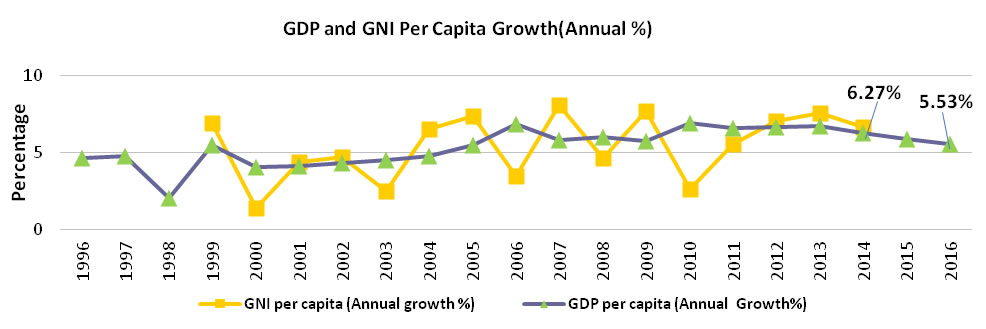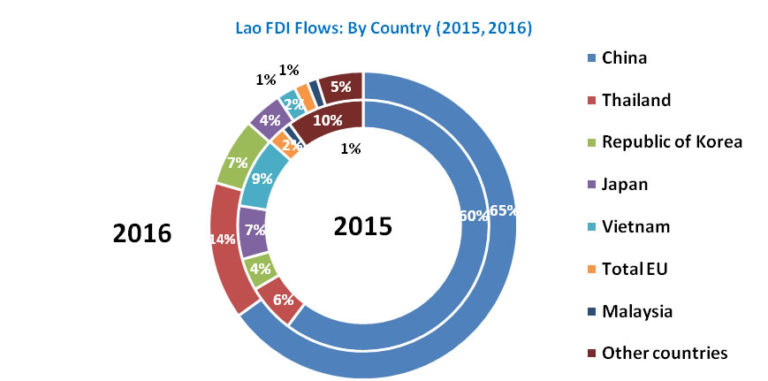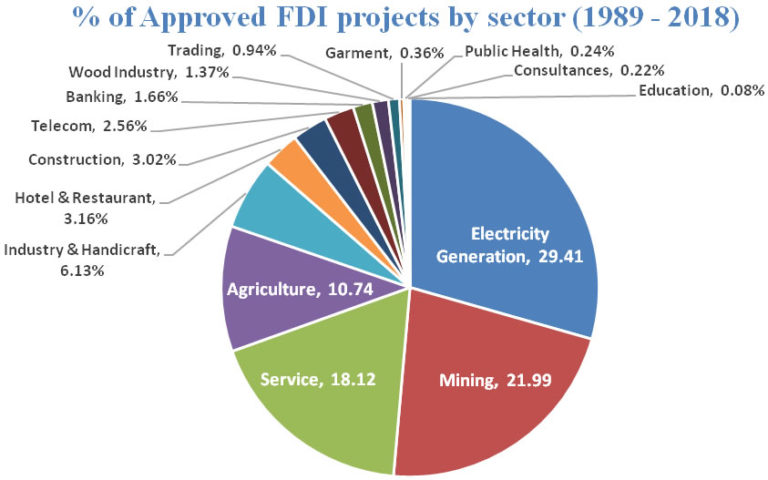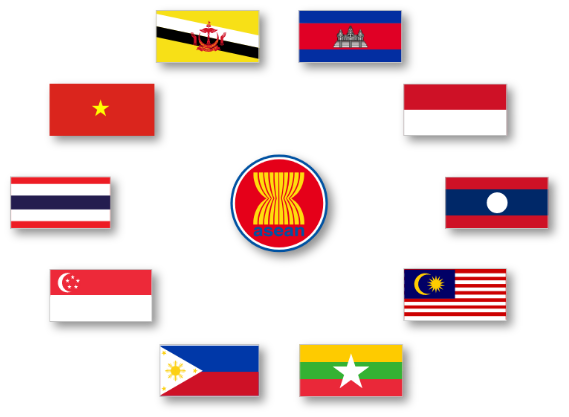WHY INVEST IN LAOS
The Lao PDR Economy Continues To Be Experience Dynamic Growth And Resilience To Withstand Global Pressures, Largely Due To The Following Factors:
01
Strong governance and transparency framework with enhanced sectorial cooperation
02
Business-friendly policies and thriving ecosystems that have opened up opportunities for foreign and local investors
03
Large infrastructure investments
04
Efficient management of natural resources
ABOUT LAOS
Lao PDR is poised to boost competitiveness and emerge as a key economy in Southeast Asia, and transforming itself into one of the most dynamic countries in the region, offering diverse business opportunities to both domestic and foreign investors. becoming the preferred gateway to Asean markets
Land Area
236,800 km2
Capital
Vientiane Capital
Population
7,013 Millions (2018)
Labor Force
2.9 Millions
Religion
Buddhism
Literacy
85%
Language
Lao
Per Capita Income
2.599 US$ (2018)
Currency
Kip
GDP Growth
6.29 % (2018)
DRIVING A DYNAMIC AND RESILIENT ECONOMY
Lao PDR continues to demonstrate resilient, sustainable and inclusive economic growth, bucking the global downturn and is well on its way towards graduating from Least Developed Country status by 2024. Backed by outstanding progress in the last 20 years, Lao PDR is in prime position to emerge as an economic and strategic investment gateway to the ASEAN market, largely due to the 8th National Socio-Economic Development Plan (NSEDP) 2016-2020 guiding policy priorities across government to achieve the country’s economic and development transformation targets.
With a GDP that has more than doubled since 2010 and projected growth to reach US$27 billion by 2022, Lao PDR is fast cementing its position as one of the fastest growing economies in this part of the world, leveraging on its strategic position as a prime spot for cross-border investments and exports to neighboring countries.

The Lao PDR Economy Continues To Be Experience Dynamic Growth
Resilience To Withstand Global Pressures, Largely Due To The Following Factors:
- Strong governance and transparency framework with enhanced sectorial cooperation.
- Business-friendly policies and thriving ecosystems that have opened up opportunities for foreign and local investors.
- Large infrastructure investments.
- Efficient management of natural resources.
Shaping A Trade And Investment Destination Of Choice
Lao PDR is gearing up to transform into an upper middle-income economy through its Vision 2030.Vision 2020 aims to quadruple per capita GDP and GNI while simultaneously increasing foreign direct investments (FDI) by shifting to new areas of comparative advantage and creating enabling environments for foreign and domestic partnerships.

Lao PDR enjoyed an exponential growth in FDI of 6.9% between 2010 and 2015, reaching over US$1.1 billion in 2015. Looking ahead, to attract quality Foreign Direct Investment (FDIs), Lao PDR has also taken progressive steps to diversify its economic base as a means for sustained and robust growth, from electricity generation, agriculture and mining sectors, which took up close to 65% of total FDI in 2015, to more into less-resource intensive sectors and higher value-added industries.


Strengthening Reforms in Governance and Transparency
To create a pro-business environment, Lao PDR has taken a whole-of-government, multi-sectoral approach to introduce strong policies with clearly defined provisions and institutionalised mechanisms that are aligned throughout ministries and local governments.
Some of the key efforts carried out to liberalise the economy and open up the private sector include:
- Vision 2030
- 8th five-year National Socio-Economic Development Plan (NSEDP) 2016-2020
- Investment Promotion Law (Amended IPL, 2016)
- Public Debt Management Law
- Strategy of Agriculture 2025
- National Organic Agriculture Strategy of Lao PDR
- New Commercial Bank Law
- Capital Adequacy Plan
- Prime Minister’s Decree on Improving EODB.
Lao PDR is gearing up to transform into an upper middle-income economy through its Vision 2030.Vision 2020 aims to quadruple per capita GDP and GNI while simultaneously increasing foreign direct investments (FDI) by shifting to new areas of comparative advantage and creating enabling environments for foreign and domestic partnerships.
Accelerating Growth via Special Economic Zones
Lao PDR has established 12 Special Economic Zones (SEZs) to create new opportunities and drive stronger growth. We aim to have 25 SEZs throughout the country by 2020.
Key roles of the SEZs:
- Create clusters/new emerging industries, boost new innovations and stimulate consumption, in line with economic globalization and regional integration;
- Attract local and foreign direct investments;
- Establish a robust infrastructure network to support operations and export;
- Provide strong supply chain linkages and access to neighboring markets; and
- Develop talent to support businesses.
Since the introduction of the first SEZ in 2003, the SEZs have brought in actual investments of up to US$1.83 billion, contributed US$20,327,060 in government revenue and increased the value of exports by US$815,491,201. Accumulated investments in Lao PDR’s SEZs increased by 30% from US$1.2 billion in 2015 to US$1.8 billion in 2017.
As at 31 December 2018, there were almost 400 foreign and domestic companies registered in the service sector, industry and trade. More than half are from China (181 businesses), Thailand (28) and Japan (30), representing companies like Aeroworks, Essilor, Nikon, Toyota, and Mascot among others.
Improving Efficiency via One-Stop-Service (OSS) Centres
The government has set up One-Stop-Service (OSS) centres within SEZs to provide investors access to comprehensive support and centralised information on investing in Lao PDR. For instance, the Savan Seno OSS Centre which benefits from the Prime Minister’s Decree 177 has set the standard in providing on-site approvals for permits, licenses as well as facilitates other investment procedures
| Savan Seno SEZ OSS Centre | Other OSS Centre | |
| Main business permit | Within five (5) working days | One to Two weeks |
| Work permits | Within one (1) working day | Eight (8) working days |
| Import – Export licenses | Within two (2) hours | At least five (5) working days |
Backed by tailored policies and frameworks, the OSS centres are managed by highly-skilled workforce that are trained to inform investors of opportunities as well as provide efficient and seamless end-to-end investor services.

Key service offerings at OSS Centres:
- Address investor queries and assist in identifying the best investment platform;
- Provide latest information on promotions, policy and regulatory changes;
- Conduct transactions relating to enterprise and business license applications;
- Fast-track application processes and facilitate business-related barriers;
- Centralized comprehensive information on incentives and tax reforms; and
- Provide aftercare services.
Leveraging on Distinct Advantages
Lao PDR’s engine of growth has been powered by its vast reserve of natural resources, namely agriculture, forestry, minerals (gold, copper, zinc and lead), electricity generated from hydro-power and tourism.
| Sector | Details |
| Hydropower | Major exporter of electricity as two thirds of electricity generated in Lao PDR is exported to Thailand, Vietnam and Cambodia, where demand continues to rise. Known as the Battery of ASEAN, Lao PDR aims to cater to domestic and regional demand (distribute electricity to neighbouring countries, set up stations, control centres and build skilled team). Key landmark projects include NT2 and the EDL-GE Projects. |
| Agriculture | Availability of a high ratio of land for agriculture and agriculture forestry Government promotes contract farming and Organic farm. |
| Manufacturing | Aims to be a manufacturing base given its close proximity to other countries and low production cost Promote the setting up of manufacturing bases at SEZs that have attractive incentives |
| Tourism | A key economic driver, tourism contributed around US$2 billion or 13.7% of GDP in 2017. This is expected to rise to US$3.3 billion by 2028. Key tourist attractions are the Mekong River, the UNESCO World Heritage sites at Luang Prabang, Vat Phou, and the Xiangkhoang Plateau. Listed as World’s No.1 in tourism, as follows: Top of “Places to Go” list in 2008 by New York times; “The best city in the world to visit” by the Wanderlust, a leading British travel magazine; “Top City” Award in 2006-2012 (except in 2009 being in top 10); “World Best Tourist Destination” in 2013 by the European Council on Tourism and Trade. “Wanderlust Travel Awards” in 2015 Lao PDR is top 10 while Luang Prabang is No.1 New areas of growth: Ecotourism, cultural tourism and agro-tourism. |
Shaping inclusive and sustainable growth
- Lao PDR is also creating future-oriented education and training programmes that will ensure young people are equipped with the right skill sets and knowledge to support growth, seize opportunities in the job market and reduce poverty.
- In driving the country’s socio-economic transformation agenda, it has already achieved poverty-related Millennium Development Goals (MDG) by halving its poverty rate by 2015.
- Recognizing the importance of building a solid foundation for future generations, Lao PDR has also undertaken the Health Sector Strategy 2020, National Nutrition Strategy (2015 – 2023) and Plan of Action (2016 – 2020) to improve healthcare, and is gearing up to implement universal health coverage with support from development partners.

Regional Integration
Poised to emerge as a key economy in the region, Lao PDR is on track to transform itself into one of the most dynamic countries in Southeast Asia, offering diverse business opportunities to both domestic and foreign investors alike. Bordering key markets – Thailand, China, Vietnam, Cambodia and Myanmar – this land-linked country is at the heart of ASE AN, with strong bilateral trade and investment ties with key economies in the region and beyond, leveraging on the establishment of the ASEAN Economic Committee (AEC), as well as ASEAN’s trade and investment partners.
Aside from being a member of the World Trade Organization (WTO) since 2013, it also has:
– unilateral trade agreements with 39 nations,
– bilateral investment treaties with 28 nations, and
– General Special Preferences (GSP) privileges with 42 countries.
I. AT THE HEART OF REGIONAL INTEGRATION
Lao PDR is at the heart of ASEAN, one of the most dynamic regions in the world. It has strong bilateral trade and investment ties with key economies in the region and beyond, leveraging on the establishment of the ASEAN Economic Committee (AEC), as well as ASEAN’s trade and investment partners. China: 65% of total FDI inflows in 2016; second largest trade partner, Thailand: 14% of FDI in 2016; largest trade partner, Vietnam: 2% of FDI in 2016; third largest trade partner
Lao PDR has the strategic geographic advantage of being land-linked, bordering key ASEAN markets including Thailand, Vietnam, Cambodia, and Myanmar. It also borders China in the north and is a key node in the One Belt, One Road Initiative.
To date, Lao PDR has bilateral investment treaties with 27 countries and has been a member of the World Trade Organisation (WTO) since 2013.

II. A DYNAMIC AND RESILIENT ECONOMY
Lao PDR is a dynamic economy, with GDP averaging between 7.8 and 8% in the last 10 years. Its resilience and increasing competitive environment have created attractive investing opportunities. Sound planning underpins Lao PDR’s economic growth. Short, medium and long-term planning are key elements of this, with the 8th National Socio-Economic Development Plan (NSEDP) 2016-2020 guiding policy priorities across government in line with the country’s economic and development transformation targets. As a result of its effective reform agenda, the International Monetary Fund (IMF) signalled its confidence in the Lao economy by projecting 6.8% real GDP growth for 2018, the second highest in Southeast Asia (after Myanmar and Cambodia with 6.9%).

Meanwhile, diversification is supported by investment flows into various sectors and contributions to GDP are becoming increasingly service-driven. Between 1988 to 2018, Lao PDR continued to see FDIs focused around the energy sector (30%), mining (22%), construction (11%), agriculture (10%) and services (9%). However, as of 2016, non-resource-based industries accounted for substantial shares of investment such as include services (11%), handicrafts (8%), hotel & restaurant (4%), construction (4%), banking and trading (3%), and telecommunications (3%). Additionally, in 2016, the services sector contributed 38.9% of GDP, outpacing the growth of industry at 28.8% and agriculture at 23.3%.
The government is leveraging on the country’s 12 Special Economic Zones (SEZs). Some including the Savan Seno SEZ have shown great success in promoting EODB, including services for start-up, aftercare, logistics and linkage with key neighbouring markets promoting value chain advancement and backward linkages to the local economy.
